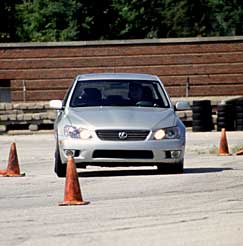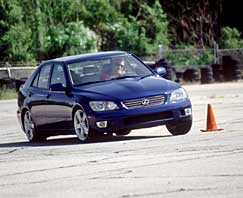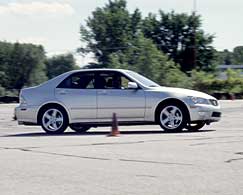Sometimes different weather conditions don’t call for different tires, just a different kind of tire. So if you
drive a high performance vehicle and live in an area where winter weather brings cold temperatures and
occasional light snow, Ultra High Performance All-Season tires may be just right for you.
However as a rule, Ultra High Performance All-Season tires have the most difficult performance goals to reach
because their tire category’s name "promises" ultra high performance in all seasons. Yet when you consider the
varying tasks asked of a tire that is expected to provide traction and performance in spring’s rain, summer’s
heat and winter’s cold, ice, and snow, it’s understandable that a blending of capabilities is necessary and that
some compromises have to be made. But in the end, how well an All-Season tire’s capabilities are blended - or
how little it compromises performance under different weather conditions ultimately determines how well it
serves its driver.
The Michelin Pilot Sport A/S (A/S for All-Season) is an Ultra High Performance All-Season tire that was designed
to deliver road-gripping, corner-hugging, all-season traction that enables drivers to push their performance
vehicle a little harder in virtually any weather condition, even light snow. The Michelin Pilot Sport A/S was
developed to be the Ultra High Performance All-Season tire that maximizes All-Season traction while minimizing
compromises.
The Pilot Sport A/S radial’s development began with a clean sheet of paper, but in this case, the clean sheet
thinking not only refers to the tire’s design, but also includes the equipment used to build it. Michelin’s
revolutionary C3M Technology assembles tires in ways that combine flexibility with precision. Michelin has been
using the C3M Technology for almost five years and has previously produced some of their other Pilot performance
tire lines with it. The Pilot Sport A/S radial’s design optimizes the advantages of C3M Technology’s precision
assembly to deliver the maximum performance possible. In fact, the Michelin Pilot Sport A/S is such a high-tech,
precisely manufactured tire, it can’t be built any other way - or by any other company.
In order to get a better understanding of the performance and comfort provided by today’s Ultra High Performance
All-Season tires, Tire Rack Team conducted a Ride & Drive comparing the Michelin Pilot Sport A/S to the Dunlop SP Sport 5000 and
Pirelli P7000 SuperSport. We used the 225/50R16 sized tires mounted on 16"x7.5" wheels fitted to three 2001
Lexus IS300 sport sedans equipped with Eibach Pro-Kit Sport Springs. Additionally, because the timing of the
Pilot Sport A/S radial’s introduction would possibly preclude our team’s opportunity to evaluate wet traction,
we were invited to also test at Michelin’s Laurens Proving Grounds in Upstate South Carolina using Ford Bullitt
Mustangs and BMW 540i sedans.
Michelin Pilot Sport A/S
 On the outside, the Pilot Sport A/S features a "three compound tread" that is made possible by the extremely
precise capabilities of Michelin’s innovative "C3M" tire manufacturing process. The Pilot Sport A/S uses
three distinct tread compounds. The first places a special high dry grip tread compound in both shoulders.
The second is a balanced dry, wet, snow and cold tread compound that is used between both shoulders and the
tire’s center rib. The third tread compound used in the center rib, has been developed to provide wet
traction confidence. These three tread compounds are molded into a directional tread design with a
continuous circumferential center rib flanked by high angle directional tread blocks. The continuous center
rib sharpens steering response and provides communicative road feel while reducing tire noise on dry roads.
The high angle lateral tread blocks enhance responsiveness and handling while the tire’s circumferential and
high angle lateral grooves efficiently evacuate water from under the contact patch to resist hydroplaning
and enhance wet traction.
On the outside, the Pilot Sport A/S features a "three compound tread" that is made possible by the extremely
precise capabilities of Michelin’s innovative "C3M" tire manufacturing process. The Pilot Sport A/S uses
three distinct tread compounds. The first places a special high dry grip tread compound in both shoulders.
The second is a balanced dry, wet, snow and cold tread compound that is used between both shoulders and the
tire’s center rib. The third tread compound used in the center rib, has been developed to provide wet
traction confidence. These three tread compounds are molded into a directional tread design with a
continuous circumferential center rib flanked by high angle directional tread blocks. The continuous center
rib sharpens steering response and provides communicative road feel while reducing tire noise on dry roads.
The high angle lateral tread blocks enhance responsiveness and handling while the tire’s circumferential and
high angle lateral grooves efficiently evacuate water from under the contact patch to resist hydroplaning
and enhance wet traction.
 On the inside, two high-tensile, lightweight steel cord belts are uniquely angled to blend good ride quality
with progressive handling. The steel belts are reinforced with Michelin’s "Filament At Zero" (FAZ)
technology to further support the tread area by continuously spiral wrapping an individual strand of Kevlar
across the entire tread area under the steel belts, and then above the steel belt’s outer edges. FAZ
technology enhances tire wear and ride comfort along with predictable handling and high speed durability.
On the inside, two high-tensile, lightweight steel cord belts are uniquely angled to blend good ride quality
with progressive handling. The steel belts are reinforced with Michelin’s "Filament At Zero" (FAZ)
technology to further support the tread area by continuously spiral wrapping an individual strand of Kevlar
across the entire tread area under the steel belts, and then above the steel belt’s outer edges. FAZ
technology enhances tire wear and ride comfort along with predictable handling and high speed durability.
 On the road, the Michelin Pilot Sport A/S was praised for its "Real World" handling, as well as, its good
noise and ride comfort qualities. The tire’s ability to envelop tar strips and absorb expansion joints was
good, and even seemed to improve with speed, providing the most comfortable ride of the three tires,
especially at highway speeds.
On the road, the Michelin Pilot Sport A/S was praised for its "Real World" handling, as well as, its good
noise and ride comfort qualities. The tire’s ability to envelop tar strips and absorb expansion joints was
good, and even seemed to improve with speed, providing the most comfortable ride of the three tires,
especially at highway speeds.
On Tire Rack’s test track in the dry, the Michelin Pilot Sport A/S provided good traction, stopping
distances and predictable handling, even though its dry cornering grip at the limit slightly trailed the
other two tires.
At the Michelin Laurens Proving Ground in the wet, the Pilot Sport A/S consistently provided the shortest
ABS-assisted stopping distances from 50 mph and provided confidence inspiring traction and feel on the wet
handling course. Because we didn’t evaluate these tires on our home track, we did not assign wet performance
ratings.
Dunlop SP Sport 5000
The SP Sport 5000 in the
225/50R16 size features an asymmetric tread design to provide year-round traction with performance.
Interconnected outer shoulder blocks and large independent tread blocks enhance dry cornering and stability,
while inner tread blocks are separated by sweeping tread grooves to enhance wet traction and reduce the risk
of hydroplaning. Full-face, cross-cut sipes are engineered into the tread pattern to provide multiple biting
edges for even greater wet grip and all-season traction, and an exclusive high performance all-season tread
compound is used to blend grip, rolling resistance and treadwear to meet a wide range of driving and weather
conditions.
Internally, the SP Sport 5000 tire’s twin steel belts are reinforced by Dunlop’s JointLess Band (JLB)
technology which uses spirally wound nylon strips above the steel belts to provide long term integrity under
high speed conditions while it reduces weight and helps provide more uniform ride quality. The SP Sport 5000
tires feature sidewalls that resist lateral deflection to generate cornering force, while Max Flange Shield
(MFS) rim protector ribs help protect alloy wheels from curb damage.
On the road, the Dunlop SP Sport 5000 was also praised for its "Real World" handling, and its good noise and
ride comfort qualities.
On Tire Rack’s test track in the dry, the Dunlop SP Sport 5000
was considered to provide the most traction (resulting in the highest cornering speeds and shortest stopping
distances) even though its responsiveness when turning into a corner or during transitions slightly trailed
the other two tires. The Dunlop SP Sport 5000 radial’s tread compound was the fastest wearing during our
days of track testing.
At the Michelin Laurens Proving Ground in the wet, the Dunlop SP Sport 5000 consistently provided
ABS-assisted stopping distances from 50 mph that fell between the other two tires and provided good traction
and feel on the wet handling course. Because we didn’t evaluate these tires on our home track, we did not
assign wet performance ratings.
Pirelli P7000 SuperSport
Many of the P7000 SuperSport ’s features are integrated into its multi-purpose directional tread design.
Twin circumferential grooves flank the center rib to channel water while additional diagonal and inclined
circumferential grooves further minimize hydroplaning. The continuous center rib provides constant road
contact to enhance straight-line tracking and dry road response. The tread is molded out of Pirelli’s 100%
silica compound with siped independent shoulder and intermediate tread blocks to provide biting edges that
generate light snow traction. On the inside, the P7000 SuperSport radial features twin steel belts
reinforced by nylon that stabilize the tread area to enhance handling and high speed durability. The rayon
carcass (either one- or two-ply depending on tire size) uses Kevlar reinforced beads to provide sharp
steering response.
On Tire Rack’s test track in the dry, the Pirelli P7000 SuperSport combined good dry traction with the
fastest steering response. However, the P7000 SuperSport’s ability to manage power oversteer (such as when
exiting our skidpad portion of the track) only allowed it to run lap times that fell between the other two
tires.
At the Michelin Laurens Proving Ground in the wet, the Pirelli P7000 SuperSport radial’s ABS-assisted
stopping distances from 50 mph were consistently the longest of the three tires. On the wet handling course,
the Pirelli P7000 SuperSport provided acceptable traction and feel, but was the most difficult of the three
tires to drive at the limit. Because we didn’t evaluate these tires on our home track, we did not assign wet
performance ratings.
NOTE: While this evaluation didn’t offer our team the opportunity to compare snow traction, Michelin’s snow
traction testing during the Pilot Sport A/S development indicates that it is equivalent to the good light
snow traction previously provided by the Pilot XGT Z4. Our experience with the Dunlop SP Sport 5000 also
indicates that it provides acceptable light snow traction, however our experience with the Pirelli P7000
SuperSport in snow indicates that it sacrifices light snow traction in favor of dry traction and it should
only be considered for areas that receive minimal amounts of light snow.

 On the outside, the Pilot Sport A/S features a "three compound tread" that is made possible by the extremely
precise capabilities of Michelin’s innovative "C3M" tire manufacturing process. The Pilot Sport A/S uses
three distinct tread compounds. The first places a special high dry grip tread compound in both shoulders.
The second is a balanced dry, wet, snow and cold tread compound that is used between both shoulders and the
tire’s center rib. The third tread compound used in the center rib, has been developed to provide wet
traction confidence. These three tread compounds are molded into a directional tread design with a
continuous circumferential center rib flanked by high angle directional tread blocks. The continuous center
rib sharpens steering response and provides communicative road feel while reducing tire noise on dry roads.
The high angle lateral tread blocks enhance responsiveness and handling while the tire’s circumferential and
high angle lateral grooves efficiently evacuate water from under the contact patch to resist hydroplaning
and enhance wet traction.
On the outside, the Pilot Sport A/S features a "three compound tread" that is made possible by the extremely
precise capabilities of Michelin’s innovative "C3M" tire manufacturing process. The Pilot Sport A/S uses
three distinct tread compounds. The first places a special high dry grip tread compound in both shoulders.
The second is a balanced dry, wet, snow and cold tread compound that is used between both shoulders and the
tire’s center rib. The third tread compound used in the center rib, has been developed to provide wet
traction confidence. These three tread compounds are molded into a directional tread design with a
continuous circumferential center rib flanked by high angle directional tread blocks. The continuous center
rib sharpens steering response and provides communicative road feel while reducing tire noise on dry roads.
The high angle lateral tread blocks enhance responsiveness and handling while the tire’s circumferential and
high angle lateral grooves efficiently evacuate water from under the contact patch to resist hydroplaning
and enhance wet traction.
 On the inside, two high-tensile, lightweight steel cord belts are uniquely angled to blend good ride quality
with progressive handling. The steel belts are reinforced with Michelin’s "Filament At Zero" (FAZ)
technology to further support the tread area by continuously spiral wrapping an individual strand of Kevlar
across the entire tread area under the steel belts, and then above the steel belt’s outer edges. FAZ
technology enhances tire wear and ride comfort along with predictable handling and high speed durability.
On the inside, two high-tensile, lightweight steel cord belts are uniquely angled to blend good ride quality
with progressive handling. The steel belts are reinforced with Michelin’s "Filament At Zero" (FAZ)
technology to further support the tread area by continuously spiral wrapping an individual strand of Kevlar
across the entire tread area under the steel belts, and then above the steel belt’s outer edges. FAZ
technology enhances tire wear and ride comfort along with predictable handling and high speed durability.
 On the road, the Michelin Pilot Sport A/S was praised for its "Real World" handling, as well as, its good
noise and ride comfort qualities. The tire’s ability to envelop tar strips and absorb expansion joints was
good, and even seemed to improve with speed, providing the most comfortable ride of the three tires,
especially at highway speeds.
On the road, the Michelin Pilot Sport A/S was praised for its "Real World" handling, as well as, its good
noise and ride comfort qualities. The tire’s ability to envelop tar strips and absorb expansion joints was
good, and even seemed to improve with speed, providing the most comfortable ride of the three tires,
especially at highway speeds.
